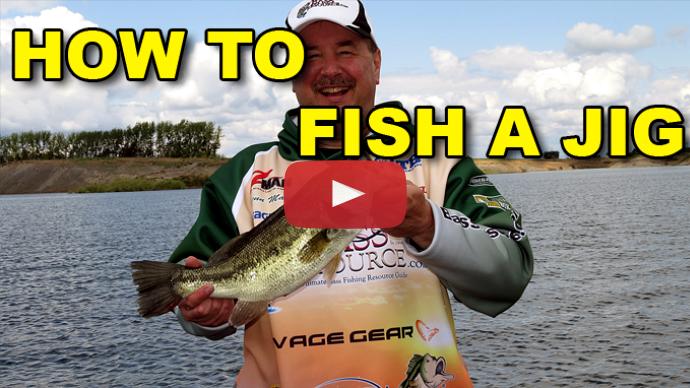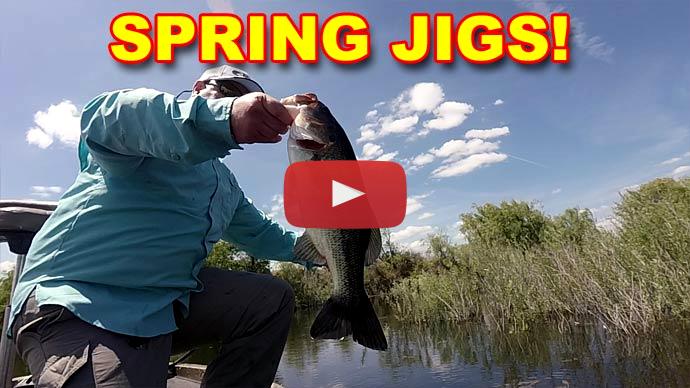Hey, BassResource. James Niggemeyer here. I wanna share a technique with you that over the years I've really grown to be very fond of. It's got a special spot in my Ranger boat, and that's the swim jig presentation.
It's a technique that'll work anywhere in the country, 12 months in a year, as well as for all species of bass whether it's largemouth, smallmouth, or spotted bass. I've had so much enjoyment out of it not only for fun, but it's also put some incredible fish in my livewell and it actually earned me some money at different stops on tour.
So with that, let's get into this swim jig. I've got some great footage of me on the water, fishing a swim jig. Here we go.
All right, I do like to jerk it and just give it...just impart some action so that thing is fluttering in the water and it looks like it's trying to get away from something that might be pursuing it. But it's a great way to cover water and it really has been a tremendous bait for me in different tournaments over the years from say January to right through the fall.
Sometimes, those fish want you to work it a certain way. And so keep an open mind. Sometimes, a straight retrieve, a slow roll is good and other times, high in the water column like today on this low-light situation or on this low-light conditions, a higher in the water column can be really good.
On those brighter days with clear water, slow-rolling it may be a little more in order. So definitely, play with your retrieves and let the fish kinda show you what they like.
One of the things that makes it really good is it's super subtle. So the fish don't hear or see it until it's right up there near them. And sometimes, that can really draw a reaction strike from them because it's something where they just have to either put up or shut up. They either need to strike it or let it go by and it makes them...it kinda pulls that reaction strike out of those fish, which is, I think, critical in some events where fish aren't actively feeding.
But I'm talking about swim jigs as they pertain to shallow water drawing reaction strikes, places where you'd throw a spinnerbait. One of the things that...this is a great go-to when a fish has kinda shied away from the flash and the brightness and the overall loudness of a spinnerbait. They will still eat a swim jig which makes it such a productive way to catch fish year-round.
The colors that I use, I use basically three different colors. I use a green pumpkin, a white or shad pattern, and then a black and blue. Those are the real three colors that I fish with. I don't try to get too fancy with it. Every once in a while, I'll hand-tie something that's just basically a variation of one of those... There's one.
Yes, look at that good one right there, too. And he just ate it just like you would on a spinnerbait. I got it right in the corner of the mouth. And just a great technique, a way to catch them. If you've not tried swim jigging, this is something you ought to try. I've kinda twisted up my line because I've been throwing it around a bunch covering a lot of water.
Put her back. All right. But that's a quarter ounce, the sizes I generally fish are quarter and three-eighth. And every once in a while, I'll throw a half and catch them on that. If I wanted to get...you know, if I wanna be able to move the swim jig faster, then that half-ounce enables me to do that and draw a reaction strike from fish generally in clearer water.
But for me, I've had the most success, again, with that menace grub, the rage craw, and then the little Swim'n Caffeine shad trailer. That's awesome.
So what I've seen is that I'm probably getting 65% to 70% of my strikes. So I'm gonna go ahead and take this Strike King menace grub off, and I'm gonna try, even though it's been working really well, I'm gonna try the rage craw just to slow it down. The double tails of the rage craw could slow this jig down. And maybe I'm going just a little too fast because this is a more streamlined trailer. Let's see what happens.
I'm gonna go ahead and put this Rage Craw on the back of this Strike King KVD heavy cover swim jig. Again, this is kind of a custom color that I just...I just put some purple and blue flake in the back there. And I'm gonna put this Strike King Rage Craw and I pull the first segment off of there to kinda shorten it. But with this appendages, I'm believer we're gonna get more drag and it's gonna slow that bait down some.
Even if I reel it at the same pace, it's gonna slow it down some. So I'm gonna go ahead. I'm just kinda measure where I think it's gonna come out so right about there. Then I wanna rig this thing as straight as possible. My hands are wet. As straight as possible so that it swims straight and the swim jig doesn't roll over on its side. That's one thing about swim jigs. You don't want that bait to roll over on its side. And there we go. We got it ready to go.
Yeah. It definitely slows it down. It's that double tail design of that rage craw that slows the bait down. Even if I'm still reeling it the same speed, it's gonna kinda slow it down a little bit more and kinda when I kill it a little bit, because there's more drag, it's not gonna just come through the water as fast. So when I kill it, it's actually gonna kinda stall it out and keep it high in the water column. So that's a really cool deal about just thinking about...
And if I wanted something to go even faster than the Strike King Swim'n Caffeine Shad is a better way to go. That little boot style trailer almost has no drag, just that little tail on the back there. So we're just gonna see if maybe this is what they want.
One thing about the rage craw is it definitely presents a bigger profile on the bait larger all the way around. So we'll see if they like that. It skips really well, too. That's a big plus with this bait being able to skip it.
And okay. And a Rage Craw strikes. I'm not sure if it really made that... See? That's more of a pre-spawned fish. I'm not sure if it's making that a big of a difference but just an example how that Rage Craw can get some fish, too, and how different trailers will really work well in certain situations. And they do a little different thing so you gotta experiment with them.
I really like a medium-heavy rod. This is a seven-foot-three-and-a-half. This is actually a Lew’s Mark Rose. It's out of his Ledge series. But I like this length particularly because it's long enough that I can really throw it way out there, but it's also just short enough where I can make real precise presentations to cover that I might come across while I'm fishing throughout the day.
I like it with a 7.5 to 1 gear ratio reel, and I like that faster gear ratio reel because sometimes they'll eat that swim jig and come right to you. So you need to pick up that slack and then be able to set the hook.
I like braided line, 30-pound test braided line. I'm using the Strike King tour-grade braided line, and then I'm actually putting on a leader a lot of times. I'm using about a 6 to 8-foot leader of 16 to 20-pound test Gamma fluorocarbon. Why I do that is because I love the fact that I have no stretch in the braid but I also have the invisibility of fluorocarbon.
I notice that a lot of times when I'm fishing the swim jig, my braid is not in the water. You know, I'm fishing it in shallower water particularly and I feel like that braid being opaque sometimes can maybe turn a fish off where that translucency of the fluorocarbon can be a little bit more stealthy and actually sneak up on a fish and trick them a little bit more.
If I'm fishing on a lot cover, I go straight braid. But I really like the 30-pound test for the swim jig. I feel like for a lot of instances, you're not really doing like a flipping style presentation. It's more of a casting so using a 50 and 65-pound test, you can do it. I don't think it's necessary. The 30 has pulled some really big fish to the boat for me.
I also wanna show you guys my swim jig box because I really believe in keeping things simple. This is my swim jig, my actual swim jig box that I carry on tour that goes in my Ranger.
I believe this is what you would call a 3600 size box. It might look smaller but it's not. Basically, I've got it separated into quarter, three-eighths, and half and then just the colors that I've talked about earlier. Your whites or shad patterns, and your green pumpkins, and then your bluegill patterns, and then black and blues.
I'm keeping things simple and in that, I find that I'm having more confidence with the bait that I have tied on and I fish it well.
So that's my swim jig overview. Thank you, guys, for tuning back into my YouTube channel. I hope that if you weren't familiar with the swim jig, that you'll give it a chance. It's a tremendous fish producer. It catches some really big ones. And the thing that I think that's really cool about it is it enables me to cover lots of water and sift through areas that don't have a lot of fish, where I can find those areas where those fish are located.
If you're new to my channel, please subscribe and if you like the content that I'm putting out, please hit the Like button, drop a comment. I'd love to hear from you. Until next time, good fishing.



